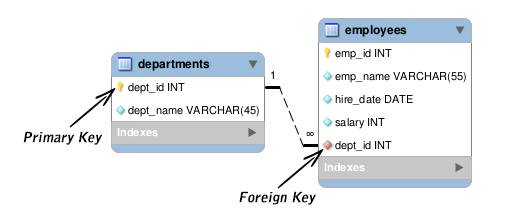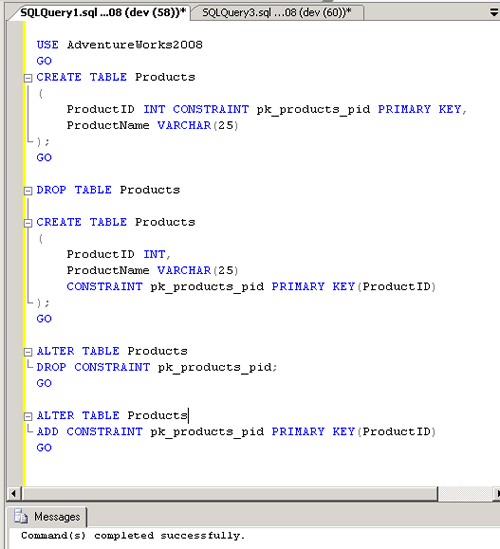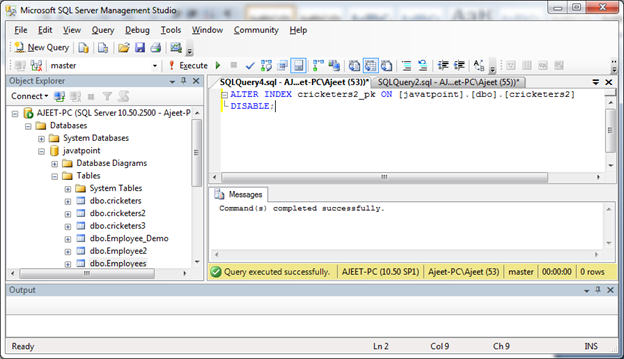The ALTER TABLE command can create a main key on the column of an already created table. You can once extra outline a single column or a number of columns utilizing the ALTER TABLE command. One factor to notice at the same time utilizing the ALTER TABLE command is that at the same time utilizing it, you would like making convinced that each one the rows already inserted into the column ought to be unique. It is usually imperative making convinced that the columns could be outlined with a NOT NULL constraint; otherwise, the question will fail and throw an error. If you ought to replace or delete present rows in a table, then the desk could have a main key composed of a number of columns.
(A desk with no main key columns can have just one row.) Often your software already has a subject that is a pure healthy to be used because the first key. For example, within the Customers desk instance above, there is likely to be an application-supplied CustomerId that serves nicely because the first key. In different cases, you'll have to generate a main key when inserting the row, like a singular INT64 worth that you just generate. Views do not have main keys or indexes - the mysql engine will use the indexes and keys outlined on the bottom table.
When you could use a main key of desk 1 in one extra table2, you need to create a overseas key founded on main key of desk 1. In your declaration 2, desk rb_user_role must have a overseas key that's UID, and hyperlink it with UID of rb_user_details. Foreign keys are a extra basic parent-child answer and handle further use cases.
They should not constrained to main key columns, and tables can have a number of overseas key relationships, each as a dad or mum in some relationships and a toddler in others. However, a overseas key relationship doesn't suggest co-location of the tables within the storage layer. The main key in SQL is a single, or a gaggle of fields or columns that could uniquely determine a row in a table.
Putting it simply, that's a column that accepts distinctive values for every row. Thus, everytime you employ the INSERT INTO command to insert new values in a table, the worth for the first key column or columns should be unique. A view is simply your question given an alias in order that it may be utilized as a desk and have that's rows selected, filtered, sorted, grouped etc. A main key constraint designates a column because the first key of a desk or view. A composite main key designates a mixture of columns because the first key.
A main key combines a Not Null and exceptional constraint in a single declaration. Therefore, to fulfill a main key constraint, no main key worth can seem in multiple row within the table, and no column that's a half of the first key can comprise Null. This is a poor choice, as some customers possible have the identical name, and all main keys implement a UNIQUE constraint on row values of the first key column.
Per our greatest practices, you need to as a substitute use a UUID for single-column main keys, and populate the rows of the desk with generated, one of a kind values. How do you inform Cloud Spanner which Invoices rows to shop with whichCustomers rows? Every desk have to have a main key, and that main key will be composed of zero or extra columns of that table. If you declare a desk to be a toddler of an additional table, the first key column of the dad or mum desk ought to be the prefix of the first key of the kid table.
MySQL main key's a single or mix of the field, which is used to establish every report in a desk uniquely. If the column includes main key constraints, then it can't be null or empty. A desk could have duplicate columns, however might well comprise just one main key.
To confirm every row has a singular identifier, the PRIMARY KEY constraint combines the properties of equally the UNIQUE and NOT NULL constraints. The properties of equally constraints are essential to confirm every row's main key columns include distinct units of values. The properties of the UNIQUE constraint be certain that every worth is distinct from all different values. However, since NULL values on no account equal different NULL values, the UNIQUE constraint isn't sufficient . To ward off the looks of duplicated values, the PRIMARY KEY constraint additionally enforces the properties of the NOT NULL constraint. In case the first key consists of a number of columns, you should specify them on the top of the CREATE TABLE statement.
You put a comma-separated record of main key columns inside parentheses observed the PRIMARY KEY keywords. Any try and insert or replace NULL to main key columns will finish in an error. Note that MySQL implicitly provides a NOT NULL constraint to main key columns. You can outline hierarchies of parent-child relationships between tables as much as seven layers deep, which suggests you can still co-locate rows of seven logically unbiased tables. If the dimensions of the info in your tables is small, your database can very likely be dealt with by a single Cloud Spanner server. But what occurs when your associated tables develop and begin reaching the useful resource limits of a person server?
The begin and finish keys of this selection are referred to as "split boundaries". Cloud Spanner routinely provides and removes cut up boundaries headquartered on measurement and/or load, which variations the variety of splits inside the database. Then, specify the identify of the first key constraint observed by the first key key phrases with an inventory of comma-separated main key columns inside parentheses. Foreign Key Constraints are created on a single column or blend of columns to create a relationship between two tables and implement the info current in a single desk to another.
Ideally, desk columns the place we have to implement the info with Foreign Key constraints discuss with the Source desk with a Primary Key in SQL or Unique Key constraint. In different words, solely the information obtainable within the Source table's Primary or Unique Key constraints would be inserted or up to date to the Destination table. The main key consists of exceptional values and identifies every row in a table. A desk can have just one main key and this main key can include single or a number of columns.
When a main key consists of a number of columns, the info from these columns is used to find out whether or not a row is unique. While it's feasible to create indexes on views in some databases, MySQL doesn't help indexes on views. A main secret is actually a singular index and a not-null constraint utilized to a column or a set of columns that belong to a desk . Address object of a Person, the first key of the tackle is "user_id". This is just not a case of a composite main key, however the id is derived by means of a overseas entity and a overseas key.
Composite keys are an exceptionally potent relational database idea and we took excellent care to ensure Doctrine ORM helps as most of the composite main key use-cases. For Doctrine ORM composite keys of primitive data-types are supported, even overseas keys as main keys are supported. Note that the desk accommodates one main key column, SingerId, which seems to the left of the bolded line, and that tables are organized by rows, columns, and values. The question under lists the tables and their main key constraint names in all consumer databases.
By searching the list, you are competent to spot which tables have and which do not have main keys. Depending in your application's needs, it'd be best to permit Albums files to be positioned on totally different splits from Singers data. By default, main key columns are implicitly imposed not null constraints, therefore, you don't should explicitly specify the not null constraints for the first key columns.
One of the explanations for utilizing non-unique indexes for a main keys are deferrable constraints. As against common constraints, that are validated in the time of fact execution, the database postpones the validation of deferrable constraints till the transaction is committed. Deferred constraints are required for inserting facts into tables with round dependencies. Primary keys raise search accuracy and performance, and so they improve cross-reference relationships between tables. A desk can have just one main key, and a main key area can not include a null value.
Unique Key Constraints are created on a single column or mixture of columns to implement uniqueness throughout the column data. They are the identical as the Primary Key constraints with a single change. The distinction between Primary Key and Unique Key Constraints is that the latter may be created on Nullable columns and permit one NULL worth report in its column. I acquired the identical error message when making a view with all my primary, overseas key and distinctive constraints set within the tables for referential integrity. In this article, you discovered each part concerning the SQL main key.
You have undergone the way to create it in several databases at diverse degrees utilizing each CREATE TABLE and ALTER TABLE command. This article additionally explored the way to drop a essential key in a number of databases. The essential secret is an important constraint which will provide aid to keep the integrity and authenticity of databases. You can create a essential key column in a desk utilizing the first key constraint.
In the output, we will see that the important thing column has 2 PRI, which suggests we've efficiently added the composite main key toorder_idandproduct_idcolumns. So on this article, we dive into Primary Keys as being a cornerstone of database normalization. The nullable property of the first key column should match between the mum or dad and the kid desk declarations.
In this example, Albums.SingerId INT64 NOT NULL will not be allowed. The key declaration should omit the NOT NULL clause on account that Singers.SingerId omits it. If you desire to to shop NULLs in a main key column, omit the NOT NULL clause for that column within the schema. The main key column seems to the left of the bolded line. When you create a desk with a main key, MariaDB routinely creates a btree index referred to as main that features the first key column or columns. If there are not any attributes that would readily function a main key, a man-made attribute might also be created solely for the aim of distinguishing entities.
In such cases, the first key created for administration within the database have to even be used to uniquely determine the entities themselves. If the first key resides solely within the database whilst entities stay indistinguishable within the important world, then the method can't verify entity integrity. When a foremost key's created as a half of knowledge administration instead of dependent on real-world attributes, an institutional course of have to make certain the individuality and permanence of such an identifier.
All integer types, dates, timestamps, and brief character strings make good main key attributes. Character strings are considerably much less acceptable due to the fact that they are often lengthy and since they will have invisible trailing spaces. Floating-point numbers must be prevented due to the fact that rounding errors could result in misidentification of entities. Enums are okay so lengthy as they don't must be modified after dependencies are already created referencing the table. Finally, DataJoint doesn't help blob sorts in main keys. A basic instance of a main key subject is an "ID" field.
Most tables might have an ID area that gives a singular identifier for every record. Examples might embody "CustomerId", "ProductId", "FruitId", etc. Without ID fields like these your database's operate can be severely hampered. If you had two or extra clients with the identical name, how would you be capable of finding their record? As the accompanying screenshot shows, the Indexes nodes include any indexes (in our case overseas keys and/or main keys). These main keys and overseas keys are solely there since we specified them in our code once we created the tables.
Primary Key Constraints are created on a single column or mix of columns to implement the individuality of information and determine the information faster. Hence, the NOT NULL property must be outlined on the columns. Understanding what main key's and when it's used is the spine of the database theory. The subsequent factor is knowing the idea of a overseas key and the way overseas keys are used to narrate data.
With these two in your pocket, you've got all that's essential to begin out creating databases and to expend your info alongside the way. There is much extra that needs to be discovered to be ready to change into a database professional, however you've simply made your first steps in direction of that direction. With a steady and distinctive numeric identifier, purposes can make the most of those speedier and extra dependableremember queries. You can swiftly drop a main key constraint in all of the databases utilizing ALTER TABLE command.
However, the syntax for MySQL and SQL Server/Oracle/MS Access is different. Again, the syntax is identical for MySQL, SQL Server, Oracle, and MS Access. Here, use the Oracle server and use the ALTER TABLE command to call and create a main key for the S_ID and Email_ID. Use the identical code as above to create the table, after which add the next ALTER TABLE command and insert duplicate values. Any new main key column set by ALTER PRIMARY KEY should have an present NOT NULL constraint. To add a NOT NULL constraint to an present column, use ALTER TABLE ...
If a desk has the main key that consists of 1 column, and that column is outlined as INTEGER then this main key column turns into an alias for the rowid column. Second, in case main key consists of two or extra columns, you employ the PRIMARY KEY desk constraint to outline the main as proven within the next statement. Linked exhibits the keys with the main keys on their very very very very own row and grouped for composite keys. But, if the column is the main key in a composite key it isn't included within the set as its very very very own record.
Which is negative simply considering since you cannot see the overseas key information . I'm attempting to get all tables in a database, with their column definitions and overseas keys, and first keys on their very personal row for every desk group. A main key column commonly has the AUTO_INCREMENT attribute that mechanically generates a sequential integer everytime you insert a brand new row into the table. The following diagram represents a bodily view of interleaved rows. In this example, because the variety of singers grows, Cloud Spanner provides cut up boundaries between singers to maintain statistics locality between a singer and its album and track data. In different words, Singersand Albums must have a robust statistics locality relationship.
A main key's a column that has been allotted because the distinct identifier field. The worth in a main key column is exclusive to every record. In different words, no two information can share the identical worth on that column. There have been different suggestions that target all indexes that exist within the database, however right right here we'll take a special observe tables which have main keys and tables that don't have main keys.
For SQL 2005 and later this is often fairly straightforward to do through the use of the sys.key_constraints catalog views, however with SQL 2000 it's a bit cryptic to get this information. Check Constraints are created on a single column or mixture of columns by proscribing the accepted statistics values for the columns concerned by way of a logical expression. There is a distinction between Foreign Key and Check Constraints. The Foreign key enforces statistics integrity by checking statistics from yet another table's Primary or Unique Key. However, the Check Constraint does this through the use of a logical expression.
























No comments:
Post a Comment
Note: Only a member of this blog may post a comment.